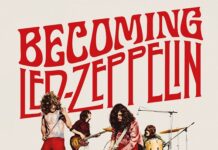While there have admittedly been quite a few articles and/or books written that focus on “the gear of the stars,” there has never been a compilation of renowned players discussing their “tools of the trade” in their own words – or, via experts (Brad Tolinski, Wolf Marshall, and Matt Pinfield, among others) that have insightful observations to add. And this serves as the set-up for the new book by author (and VintageRock.com contributor) Greg Prato, Iconic Guitar Gear.
The book’s set-up is simple — for each guitarist listed, an intro paragraph composed by yours truly kicks things off, followed by quotes detailing or discussing instruments, amplification, or effects (and in some cases, all three!).
Over 150 guitarists are featured in the book, including Jimi Hendrix, Eddie Van Halen, Randy Rhoads, Stevie Ray Vaughan, Brian May, Tony Iommi, Jimmy Page, Jeff Beck, John Lennon, Kurt Cobain, Kim Thayil, Johnny Ramone, The Edge, Gary Moore, Alex Lifeson, Yngwie Malmsteen, Steve Vai, Dimebag Darrell, Zakk Wylde, Billy Sheehan, Les Claypool, and Mike Watt, among many others.
Here are three excerpts from the book for you to enjoy…
Jimmy Page (Led Zeppelin, the Yardbirds) – as told by Brad Tolinski
What better gentleman to get the lowdown on some of Jimmy Page’s most renowned guitars from back in the Yardbirds and Zeppelin days than Brad Tolinski, the author of Light & Shade: Conversations with Jimmy Page.
“Dragon” Fender Telecaster
The times were interesting – especially with these British guitar players. Because they played what they could get – especially in Jimmy Page’s generation. These guitars were imported, so at any given time in England, there might only be a few Les Pauls available. Or a few Strats – depending on the import and export of the country and all the handful of music stores. Most of the players back then, if the guitar was good and they could get their hands on it, then it was good enough – they’d figure how to make a good sound out of it. And I find that point sort of fascinating – they took what they got and made it work, and came up with all sorts of fantastic things because of that.
So, Jimmy at the time was playing a Tele [1959]. And the Tele – the Dragon Tele – that he had was actually a Tele that he didn’t even buy. It was given to him. Back then, rock bands…it was a whole different world – a lot of times, the managers owned the musician’s gear or paid for it. So, Jimmy – famously – went into the Yardbirds. And when he went into the Yardbirds, they just gave him Jeff Beck’s Telecaster. [Laughs] “Here’s a guitar…you get this!” I mean, Jimmy had other guitars from his days of being a session musician. He had a black Les Paul that he loved, but he didn’t want to take that on tour with him – because it was his prized possession. It was too expensive. And touring back then was pretty rough and tumble – you didn’t even have flight cases, you just checked your stuff in at the airport, and it had zero protection. Amplifiers, they would just toss them into luggage and you just prayed that they’d come out the other end…and in one piece.
Billy Sheehan (Talas, David Lee Roth, Mr. Big, The Winery Dogs, Sons of Apollo)
Unquestionably, the rock bassist who received the most press coverage in the ‘80s was Billy Sheehan. And it was one of those rare instances where the onslaught of coverage was well-deserved – as he was doing for the bass guitar what Eddie Van Halen was doing for the other sorta guitar. I’ve had the opportunity to interview Sheehan quite a few times over the years, and was able to get the inside story about his famous “Wife” bass (which predated EVH’s “Frankenstein” by several years, and was also an instrument comprised of different parts).
“The Wife” Fender P-Bass (with Tele neck)
I went down to Art Kubera Music on 910 Fillmore Avenue in Buffalo, and got my first bass. It was just awesome. The smell of opening up the case – I remember it to this day. I still have the original book that came with it – that tells you how to check the intonation. A little manual that came with it, and was signed by the guy who assembled the bass, I think. Then, I saw Tim Bogert with Beck, Bogert & Appice, and he had what appeared to be a Tele bass neck on a P-Bass – on the back cover [of BBA’s self-titled album from 1973]. I talked to him years later, and that wasn’t exactly what it was, but in my mind, it was.
So, I bought a ‘68 Telecaster bass – which would be worth a fortune now, back then, it was 200 bucks – took the neck off, and put it on my P-Bass. And I loved it, because it was big and fat and giant and sustain-y and beautiful. And then that bass also had the humbucker pickup installed in the neck position – the Gibson tone. I didn’t know how to wire a switch when I put that on, so I just had two outputs, and ran two cords through two channels, so I had two cords to two different amps – and that’s how it is to this day. It’s a very handy way of doing it. It wasn’t original – I didn’t know at the time when I did it that there was such a thing as the Rick-O-Sound bass, which has a similar wiring. And also, all the Alembic basses years after that, when they came out, they were all wired with separate outputs for each pickup.
Frank Zappa – as told by Steve Vai
Frank Zappa played quite a few different guitars throughout his long and winding career. But one of his best known was a particular Fender Stratocaster, that was previously owned – and burned – by Jimi Hendrix (and that Frank posed with on the January 1977 issue of Guitar Player). Here, one-time Zappa guitarist, Steve Vai, discusses this famous instrument.
Fender Stratocaster
Frank was pretty irreverent with his gear. And from what I understand, he received that guitar after Jimi Hendrix had burned it I think in Florida at a gig [the Miami Pop Festival, in 1968]. And it came from a tech that went to Frank. And Frank took it apart and put it back together with all sorts of different electronics and everything. And I actually used it as a third spare on tour with Frank. As much as that could intimidate me [knowing that he was playing a guitar that was once played by Jimi Hendrix], it didn’t come close to the music that I had to play on it – when it comes to being intimidated. [Laughs] I thought it was cool – it’s pretty cool that I’m playing a guitar that Jimi Hendrix owned or played, and Frank Zappa owned it. But the notes have to be right – that’s all that Frank cared about. Frank took the pickup covers off – which had the lighter fluid burns on it. He put parametric EQ’s that were stacked – and I’d never seen anything like that – and he put two or three of them in. And he changed everything – it was just the body and the neck. Or maybe not even the neck – I’m not even sure about that. But Frank was irreverent – he didn’t care that Jimi Hendrix owned it, he used it as a creative outlet. And he did things to it by putting these parametrics in that were unique at the time.
The 319-page Iconic Guitar Gear is available in paperback for $14.99, hardcover for $24.99, and Kindle for $9.99, and soon, an audio version narrated by Prato himself.



















